The Relationship between Landscape Metrics and Facial Expressions in 18 Urban Forest Parks of Northern China
Abstract
1. Introduction
2. Materials and Methods
2.1. Study Sites
2.2. Data Source
2.2.1. Photo Download and Treatment
2.2.2. Landscape Metric Collection and Treatment
2.3. Facial Expression Analysis
2.4. Statistical Analysis
3. Results
3.1. Landscape Metric among Different Northern Cities Analysis
3.2. Visitors’ Facial Expressions Analysis
3.2.1. Different Ages of Visitors on Facial Expressions Analysis
3.2.2. Different Cities of Visitors on Facial Expressions Analysis
3.2.3. Cities and Ages Interaction Analysis
3.2.4. Positive Response Index Analysis
3.3. Landscape Metrics and Facial Expressions Correlation Analysis
4. Discussion
4.1. The Age Effect on Facial Expressions
4.2. The Discrepancy of Facial Expressions among Cities
4.3. Relationship between Landscape Metrics and Facial Expressions
4.4. Limitation
5. Conclusions
Author Contributions
Funding
Institutional Review Board Statement
Informed Consent Statement
Data Availability Statement
Acknowledgments
Conflicts of Interest
References
- McKenzie, K.; Murray, A.; Booth, T. Do urban environments increase the risk of anxiety, depression and psychosis? An epidemiological study. J. Affect. Disord. 2013, 150, 1019–1024. [Google Scholar] [CrossRef] [PubMed]
- Lee, J.; Park, B.-J.; Tsunetsugu, Y.; Ohira, T.; Kagawa, T.; Miyazaki, Y. Effect of forest bathing on physiological and psychological responses in young Japanese male subjects. Public Health 2011, 125, 93–100. [Google Scholar] [CrossRef]
- Shin, W.S.; Yeoun, P.S.; Yoo, R.W.; Shin, C.S. Forest experience and psychological health benefits: The state of the art and future prospect in Korea. Environ. Health Prev. Med. 2010, 15, 38–47. [Google Scholar] [CrossRef] [PubMed]
- Poulsen, D.V.; Stigsdotter, U.K.; Djernis, D.; Sidenius, U. ‘Everything just seems much more right in nature’: How veterans with post-traumatic stress disorder experience nature-based activities in a forest therapy garden. Health Psychol. Open 2016, 3, 3. [Google Scholar] [CrossRef] [PubMed]
- Carson, R.T.; DeShazo, J.; Schwabe, K.A.; Vincent, J.R.; Ahmad, I. Incorporating local visitor valuation information into the design of new recreation sites in tropical forests. Ecol. Econ. 2015, 120, 338–349. [Google Scholar] [CrossRef]
- Bahrini, F.; Bell, S.; Mokhtarzadeh, S. The relationship between the distribution and use patterns of parks and their spatial accessibility at the city level: A case study from Tehran, Iran. Urban For. Urban Green. 2017, 27, 332–342. [Google Scholar] [CrossRef]
- Hong, J.; Park, S.; An, M. Are Forest healing programs useful in promoting children’s emotional welfare? The Interpersonal relationships of children in foster care. Urban For. Urban Green. 2021, 59, 127034. [Google Scholar] [CrossRef]
- Bielinis, E.; Bielinis, L.; Krupińska-Szeluga, S.; Łukowski, A.; Takayama, N. The Effects of a Short Forest Recreation Program on Physiological and Psychological Relaxation in Young Polish Adults. Forests 2019, 10, 34. [Google Scholar] [CrossRef]
- Yu, C.-P.; Lin, C.-M.; Tsai, M.-J.; Tsai, Y.-C.; Chen, C.-Y. Effects of Short Forest Bathing Program on Autonomic Nervous System Activity and Mood States in Middle-Aged and Elderly Individuals. Int. J. Environ. Res. Public Health 2017, 14, 897. [Google Scholar] [CrossRef] [PubMed]
- Song, C.; Ikei, H.; Kobayashi, M.; Miura, T.; Li, Q.; Kagawa, T.; Kumeda, S.; Imai, M.; Miyazaki, Y. Effects of viewing forest landscape on middle-aged hypertensive men. Urban For. Urban Green. 2017, 21, 247–252. [Google Scholar] [CrossRef]
- Kabisch, N.; Püffel, C.; Masztalerz, O.; Hemmerling, J.; Kraemer, R. Physiological and psychological effects of visits to different urban green and street environments in older people: A field experiment in a dense inner-city area. Landsc. Urban Plan. 2021, 207, 103998. [Google Scholar] [CrossRef]
- Deng, L.; Li, X.; Luo, H.; Fu, E.-K.; Ma, J.; Sun, L.-X.; Huang, Z.; Cai, S.-Z.; Jia, Y. Empirical study of landscape types, landscape elements and landscape components of the urban park promoting physiological and psychological restoration. Urban For. Urban Green. 2020, 48, 126488. [Google Scholar] [CrossRef]
- Wang, R.; Zhao, J.; Meitner, M.J.; Hu, Y.; Xu, X. Characteristics of urban green spaces in relation to aesthetic preference and stress recovery. Urban For. Urban Green. 2019, 41, 6–13. [Google Scholar] [CrossRef]
- Li, Z.; Zhao, W.; Nie, M. Scale Characteristics and Optimization of Park Green Space in Megacities Based on the Fractal Measurement Model: A Case Study of Beijing, Shanghai, Guangzhou, and Shenzhen. Sustainability 2021, 13, 8554. [Google Scholar] [CrossRef]
- Grigsby-Toussaint, D.S.; Chi, S.-H.; Fiese, B.H. Where they live, how they play: Neighborhood greenness and outdoor physical activity among preschoolers. Int. J. Health Geogr. 2011, 10, 66. [Google Scholar] [CrossRef]
- Villeneuve, P.J.; Jerrett, M.; Su, J.G.; Burnett, R.T.; Chen, H.; Wheeler, A.; Goldberg, M.S. A cohort study relating urban green space with mortality in Ontario, Canada. Environ. Res. 2012, 115, 51–58. [Google Scholar] [CrossRef] [PubMed]
- Richardson, E.; Pearce, J.; Mitchell, R.; Kingham, S. Role of physical activity in the relationship between urban green space and health. Public Health 2013, 127, 318–324. [Google Scholar] [CrossRef]
- Wood, L.; Hooper, P.; Foster, S.; Bull, F. Public green spaces and positive mental health—investigating the relationship between access, quantity and types of parks and mental wellbeing. Health Place 2017, 48, 63–71. [Google Scholar] [CrossRef]
- Völker, S.; Kistemann, T. The impact of blue space on human health and well-being—Salutogenetic health effects of inland surface waters: A review. Int. J. Hyg. Environ. Health 2011, 214, 449–460. [Google Scholar] [CrossRef]
- Korpela, K.M.; Ylén, M.; Tyrväinen, L.; Silvennoinen, H. Favorite green, waterside and urban environments, restorative experiences and perceived health in Finland. Health Promot. Int. 2010, 25, 200–209. [Google Scholar] [CrossRef]
- Gascon, M.; Zijlema, W.; Vert, C.; White, M.P.; Nieuwenhuijsen, M. Outdoor blue spaces, human health and well-being: A systematic review of quantitative studies. Int. J. Hyg. Environ. Health 2017, 220, 1207–1221. [Google Scholar] [CrossRef] [PubMed]
- White, M.; Smith, A.; Humphryes, K.; Pahl, S.; Snelling, D.; Depledge, M. Blue space: The importance of water for preference, affect, and restorativeness ratings of natural and built scenes. J. Environ. Psychol. 2010, 30, 482–493. [Google Scholar] [CrossRef]
- Bedimo-Rung, A.L.; Mowen, A.J.; Cohen, D.A. The significance of parks to physical activity and public health: A conceptual model. Am. J. Prev. Med. 2005, 28, 159–168. [Google Scholar] [CrossRef]
- Giles-Corti, B.; Broomhall, M.H.; Knuiman, M.; Collins, C.; Douglas, K.; Ng, K.; Lange, A.; Donovan, R.J. Increasing walking: How important is distance to, attractiveness, and size of public open space? Am. J. Prev. Med. 2005, 28 (Suppl. 2), 169–176. [Google Scholar] [CrossRef]
- Maller, C.; Townsend, M.; Pryor, A.; Brown, P.; St Leger, L. Healthy nature healthy people: ‘contact with nature’ as an upstream health promotion intervention for populations. Health Promot. Int. 2006, 21, 45–54. [Google Scholar] [CrossRef] [PubMed]
- Sang, Å.O.; Knez, I.; Gunnarsson, B.; Hedblom, M. The effects of naturalness, gender, and age on how urban green space is perceived and used. Urban For. Urban Green. 2016, 18, 268–276. [Google Scholar] [CrossRef]
- Brown, G.; Schebella, M.; Weber, D. Using participatory GIS to measure physical activity and urban park benefits. Landsc. Urban Plan. 2014, 121, 34–44. [Google Scholar] [CrossRef]
- Peschardt, K.K.; Stigsdotter, U.K. Associations between park characteristics and perceived restorativeness of small public urban green spaces. Landsc. Urban Plan. 2013, 112, 26–39. [Google Scholar] [CrossRef]
- Shukitt, B.L.; Banderet, L.E. Mood states at 1600 and 4300 meters terrestrial altitude. Aviat. Space Environ. Med. 1988, 59, 530–532. [Google Scholar]
- Dudek, T. Influence of selected features of forests on forest landscape aesthetic value—Example of SE Poland. J. Environ. Eng. Landsc. Manag. 2018, 26, 275–284. [Google Scholar] [CrossRef]
- Hytönen, L.A.; Leskinen, P.; Store, R. A Spatial Approach to Participatory Planning in Forestry Decision Making. Scand. J. For. Res. 2002, 17, 62–71. [Google Scholar] [CrossRef]
- Michalowska, K.; Glowienka, E.; Hejmanowska, B. Temporal Satellite Images in The Process of Automatic Efficient Detection of Changes of the Baltic Sea Coastal Zone. IOP Conf. Ser. Earth Environ. Sci. 2016, 44, 042019. [Google Scholar] [CrossRef]
- Skole, D.; Tucker, C. Tropical Deforestation and Habitat Fragmentation in the Amazon: Satellite Data from 1978 to 1988. Science 1993, 260, 1905–1910. [Google Scholar] [CrossRef] [PubMed]
- Li, Y.; Liu, M.; Liu, X.; Yang, W.; Wang, W. Characterising three decades of evolution of forest spatial pattern in a major coal-energy province in northern China using annual Landsat time series. Int. J. Appl. Earth Obs. Geoinf. 2021, 95, 102254. [Google Scholar] [CrossRef]
- Hermosilla, T.; Wulder, M.; White, J.; Coops, N.C.; Pickell, P.D.; Bolton, D.K. Impact of time on interpretations of forest fragmentation: Three-decades of fragmentation dynamics over Canada. Remote. Sens. Environ. 2019, 222, 65–77. [Google Scholar] [CrossRef]
- Bohlin, J.; Wallerman, J.; Fransson, J.E.S. Forest variable estimation using photogrammetric matching of digital aerial images in combination with a high-resolution DEM. Scand. J. For. Res. 2012, 27, 692–699. [Google Scholar] [CrossRef]
- Cañas, I.; Ayuga, E.; Ayuga, F. A contribution to the assessment of scenic quality of landscapes based on preferences expressed by the public. Land Use Policy 2009, 26, 1173–1181. [Google Scholar] [CrossRef]
- Pal, S.; Mukhopadhyay, S.; Suryadevara, N. Development and Progress in Sensors and Technologies for Human Emotion Recognition. Sensors 2021, 21, 5554. [Google Scholar] [CrossRef]
- Palermo, R.; Rhodes, G. Are you always on my mind? A review of how face perception and attention interact. Neuropsycholgia 2007, 45, 75–92. [Google Scholar] [CrossRef]
- Mumenthaler, C.; Sander, D.; Manstead, A. Emotion Recognition in Simulated Social Interactions. IEEE Trans. Affect. Comput. 2018, 11, 1. [Google Scholar] [CrossRef]
- Li, D.; Jia, J.; Wang, X. Unpleasant Food Odors Modulate the Processing of Facial Expressions: An Event-Related Potential Study. Front. Neurosci. 2020, 14, 686. [Google Scholar] [CrossRef]
- Stock, J.V.D.; Peretz, I.; Grèzes, J.; de Gelder, B. Instrumental Music Influences Recognition of Emotional Body Language. Brain Topogr. 2009, 21, 216–220. [Google Scholar] [CrossRef] [PubMed][Green Version]
- Robin, O.; Alaoui-Ismaïli, O.; Dittmar, A.; Vernet-Maury, E. Basic Emotions Evoked by Eugenol Odor Differ According to the Dental Experience. A Neurovegetative Analysis. Chem. Senses 1999, 24, 327–335. [Google Scholar] [CrossRef] [PubMed]
- Wei, H.; Ma, B.; Hauer, R.J.; Liu, C.; Chen, X.; He, X. Relationship between environmental factors and facial expressions of visitors during the urban forest experience. Urban For. Urban Green. 2020, 53, 126699. [Google Scholar] [CrossRef]
- Lee, J.; Tsunetsugu, Y.; Takayama, N.; Park, B.-J.; Li, Q.; Song, C.; Komatsu, M.; Ikei, H.; Tyrväinen, L.; Kagawa, T.; et al. Influence of Forest Therapy on Cardiovascular Relaxation in Young Adults. Evid. Based Complement. Altern. Med. 2014, 2014, 1–7. [Google Scholar] [CrossRef] [PubMed]
- Wei, H.; Hauer, R.J.; Chen, X.; He, X. Facial Expressions of Visitors in Forests along the Urbanization Gradient: What Can We Learn from Selfies on Social Networking Services? Forests 2019, 10, 1049. [Google Scholar] [CrossRef]
- Karbauskaitė, R.; Sakalauskas, L.; Dzemyda, G. Kriging Predictor for Facial Emotion Recognition Using Numerical Proximities of Human Emotions. Informatica 2020, 31, 249–275. [Google Scholar] [CrossRef]
- Kerrihard, A.L.; Khair, M.B.; Blumberg, R.; Feldman, C.H.; Wunderlich, S.M. The effects of acclimation to the United States and other demographic factors on responses to salt levels in foods: An examination utilizing face reader technology. Appetite 2017, 116, 315–322. [Google Scholar] [CrossRef]
- Wang, M.; Xu, J.-H.; Han, S.-R. A Study on the Economic Effects of Provincial Capital Bias and the Adjustment of Urban Development Strategy in China. In Proceedings of the 2018 International Conference on Management Science and Engineering (ICMSE), Frankfurt, Germany, 17–20 August 2018; pp. 390–405. [Google Scholar] [CrossRef]
- Dai, L.; Xue, T.; Wu, B.; Rong, X.; Xu, B. Spatiotemporal Structure Features of Network Check-in Activities of Urban Residents and Their Impacting Factors: A Case Study in Six Urban Districts of Beijing. J. Asian Arch. Build. Eng. 2017, 16, 131–138. [Google Scholar] [CrossRef]
- Liu, P.; Liu, M.; Xia, T.; Wang, Y.; Wei, H. Can Urban Forest Settings Evoke Positive Emotion? Evidence on Facial Expressions and Detection of Driving Factors. Sustainability 2021, 13, 8687. [Google Scholar] [CrossRef]
- Wei, H.; Hauer, R.J.; Zhai, X. The Relationship between the Facial Expression of People in University Campus and Host-City Variables. Appl. Sci. 2020, 10, 1474. [Google Scholar] [CrossRef]
- Shah, R.; Tewari, R. Demystifying ‘selfie’: A rampant social media activity. Behav. Inf. Technol. 2016, 35, 864–871. [Google Scholar] [CrossRef]
- Zhu, J.; Xu, C. Sina microblog sentiment in Beijing city parks as measure of demand for urban green space during the COVID-19. Urban For. Urban Green. 2021, 58, 126913. [Google Scholar] [CrossRef]
- Li, G.Y.; Chen, J.; Yu, F.F. Explore and Analyse of Urbanization Based on the Residential Environment Scientific Perspective. Adv. Mater. Res. 2011, 250–253, 2734–2739. [Google Scholar] [CrossRef]
- Nam, H.-E.; Lee, M.-R.; Kim, H.-S. The Study on the Relationship between Local Residents’ Perception of a Health-Cities and Personal Happiness. Korean J. Health Serv. Manag. 2014, 8, 175–185. [Google Scholar] [CrossRef]
- Lee, M.; Park, S.; Yoon, K. Do Health Promotion Programs Affect Local Residents’ Emotions? Int. J. Environ. Res. Public Heal. 2019, 16, 549. [Google Scholar] [CrossRef]
- Gong, L.; Zhang, Z.; Xu, C. Developing a Quality Assessment Index System for Scenic Forest Management: A Case Study from Xishan Mountain, Suburban Beijing. Forests 2015, 6, 225–243. [Google Scholar] [CrossRef]
- Chen, X.F.; Jia, L.M. Research on evaluation of in-forest landscapes in west Beijing mountain area. Sci. Silvae Sin. 2003, 39, 59–66. [Google Scholar]
- Bratman, G.N.; Hamilton, J.P.; Daily, G.C. The impacts of nature experience on human cognitive function and mental health. Ann. N. Y. Acad. Sci. 2012, 1249, 118–136. [Google Scholar] [CrossRef] [PubMed]
- Gozalo, G.R.; Morillas, J.M.B.; González, D.M. Perceptions and use of urban green spaces on the basis of size. Urban For. Urban Green. 2019, 46, 126470. [Google Scholar] [CrossRef]
- Maas, J.; Verheij, R.A.; Groenewegen, P.P.; de Vries, S.; Spreeuwenberg, P. Green space, urbanity, and health: How strong is the relation? J. Epidemiol. Community Health 2006, 60, 587–592. [Google Scholar] [CrossRef] [PubMed]
- Chen, Y.; Yuan, Y. The neighborhood effect of exposure to blue space on elderly individuals’ mental health: A case study in Guangzhou, China. Health Place 2020, 63, 102348. [Google Scholar] [CrossRef]
- Foley, R.; Kistemann, T. Blue space geographies: Enabling health in place. Health Place 2015, 35, 157–165. [Google Scholar] [CrossRef] [PubMed]
- Sonntag-Öström, E.; Stenlund, T.; Nordin, M.; Lundell, Y.; Ahlgren, C.; Fjellman-Wiklund, A.; Järvholm, L.S.; Dolling, A. “Nature’s effect on my mind”—Patients’ qualitative experiences of a forest-based rehabilitation programme. Urban For. Urban Green. 2015, 14, 607–614. [Google Scholar] [CrossRef]
- Nutsford, D.; Pearson, A.L.; Kingham, S.; Reitsma, F. Residential exposure to visible blue space (but not green space) associated with lower psychological distress in a capital city. Health Place 2016, 39, 70–78. [Google Scholar] [CrossRef]
- Bertram, C.; Meyerhoff, J.; Rehdanz, K.; Wüstemann, H. Differences in the recreational value of urban parks between weekdays and weekends: A discrete choice analysis. Landsc. Urban Plan. 2017, 159, 5–14. [Google Scholar] [CrossRef]
- Chao, C.-C.; Chen, L.H.; Lin, Y.-C.; Wang, S.-H.; Wu, S.-H.; Li, W.-C.; Huang, K.-F.; Chiu, T.-F.; Kuo, I.-C. Impact of a 3-Day High-Altitude Trek on Xue Mountain (3886 m), Taiwan, on the Emotional States of Children: A Prospective Observational Study. High Alt. Med. Biol. 2019, 20, 28–34. [Google Scholar] [CrossRef]
- Su, J.D. The Effect of Different Forest Landscape Spaces on the Physical and Mental Recovery of College Students; Shenyang Agriculture University: Shenyang, China, 2020. [Google Scholar] [CrossRef]
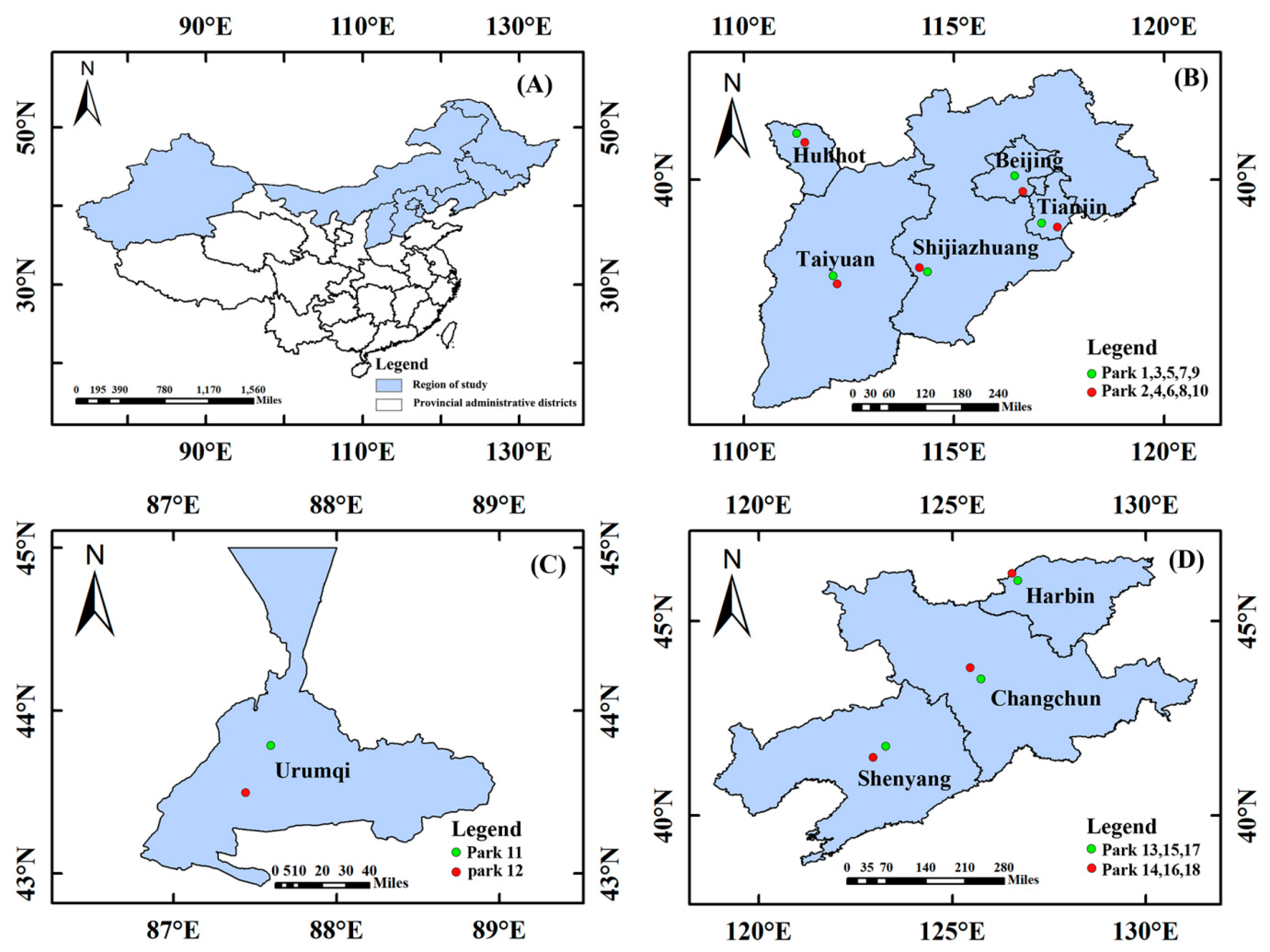
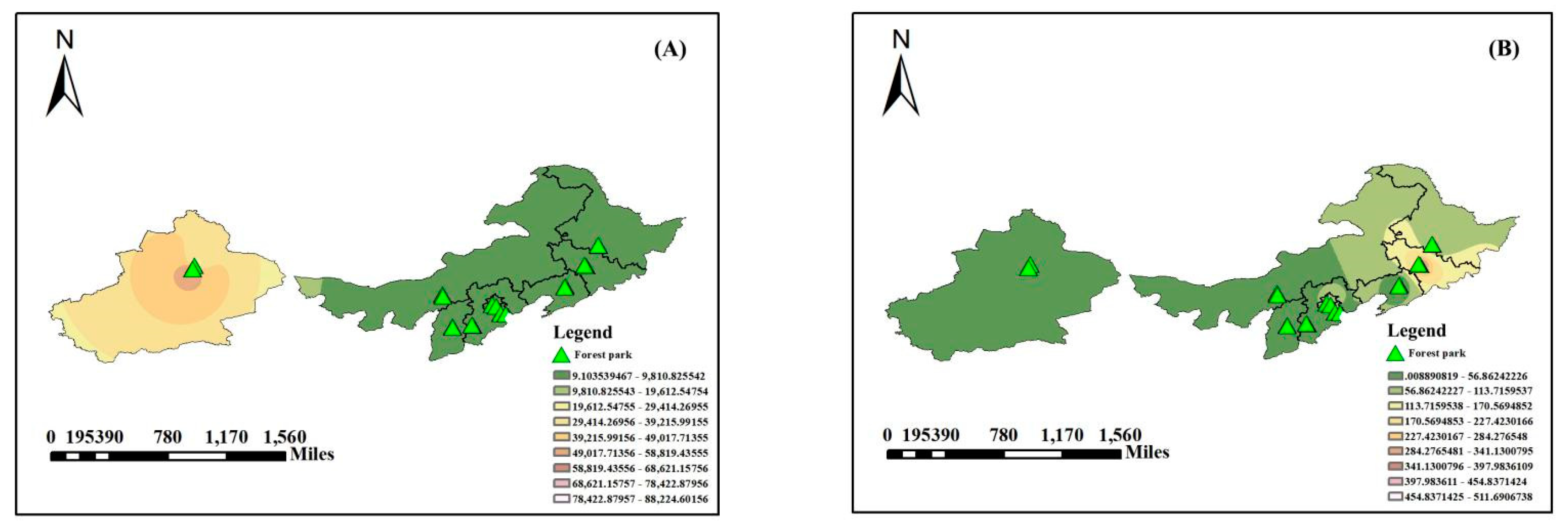
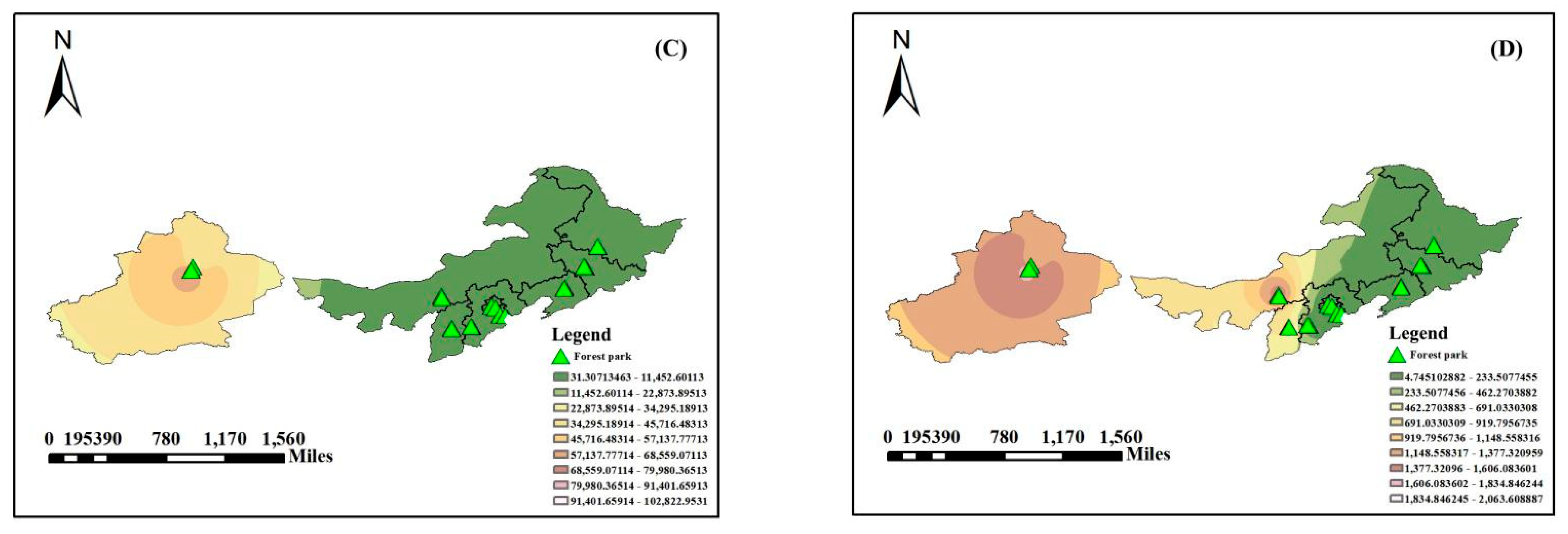
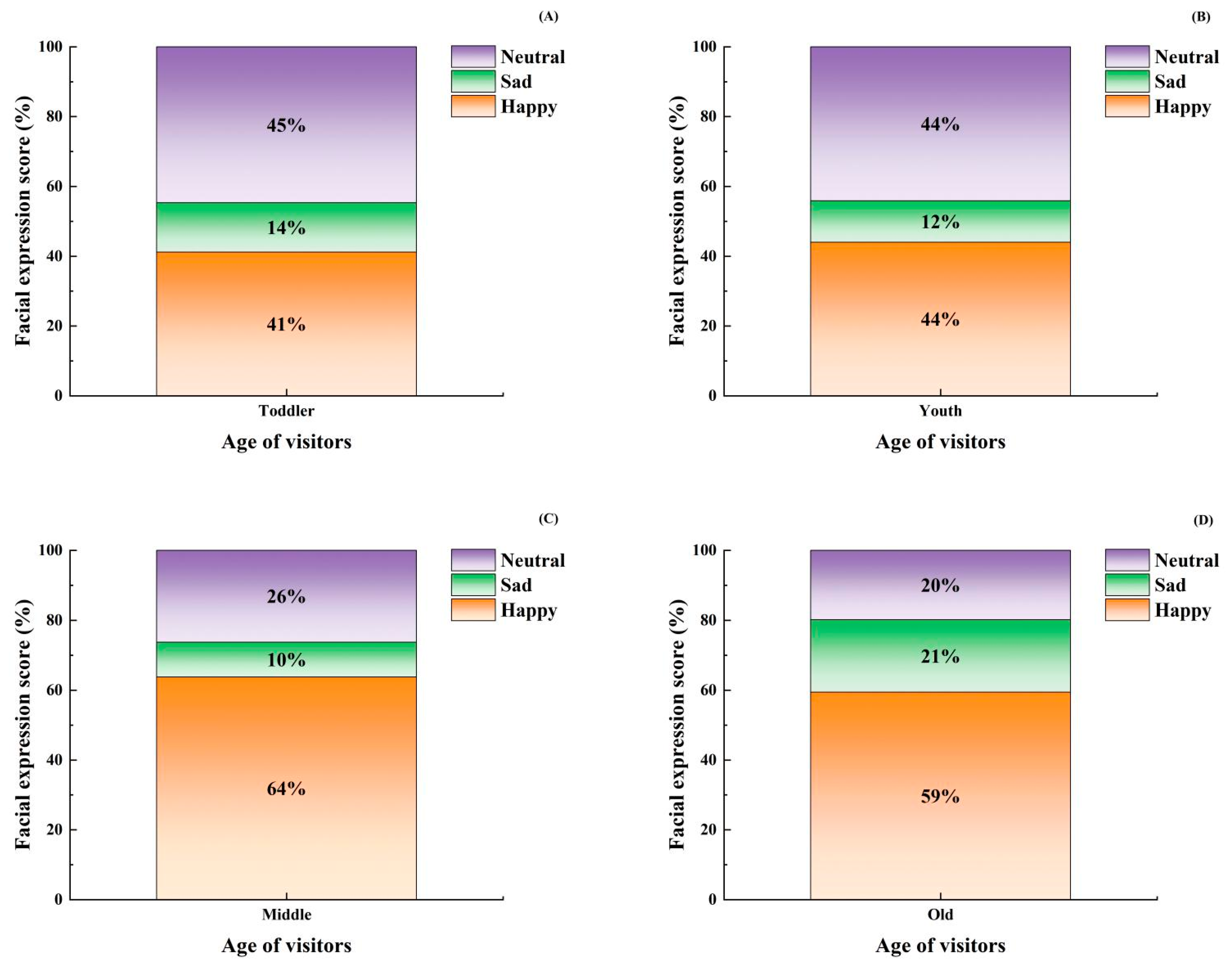
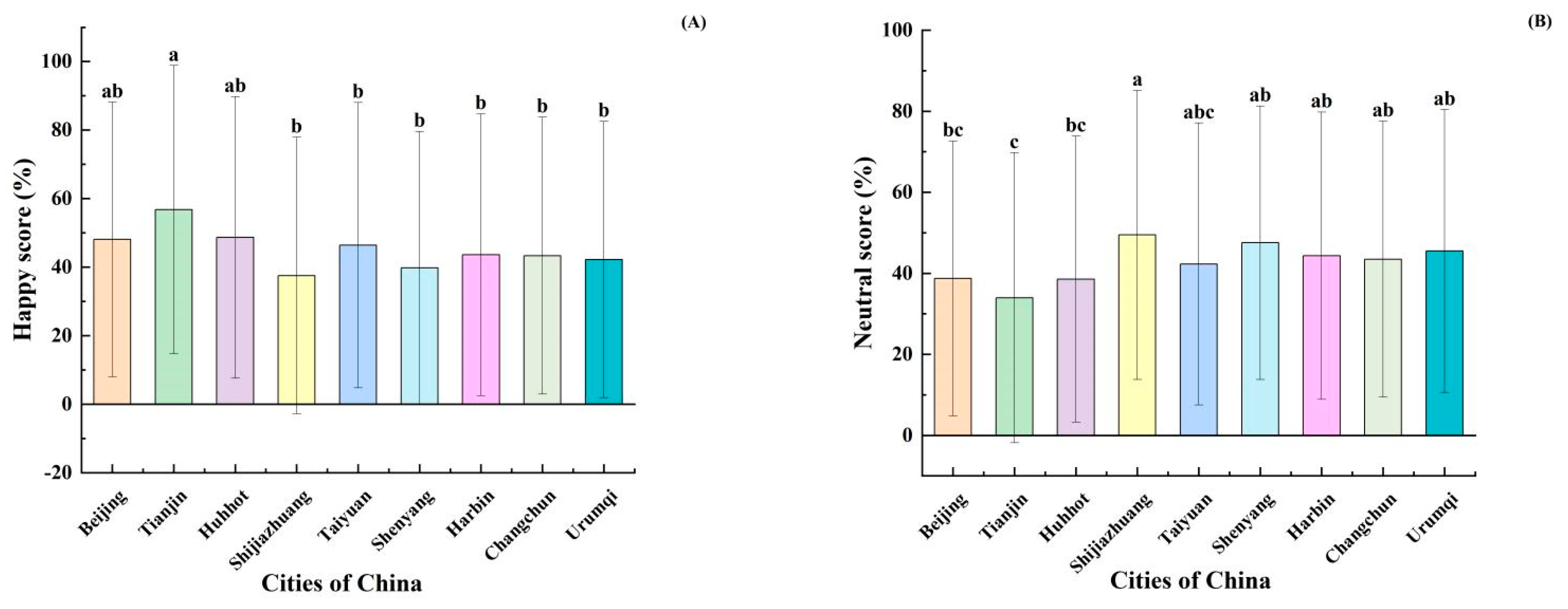
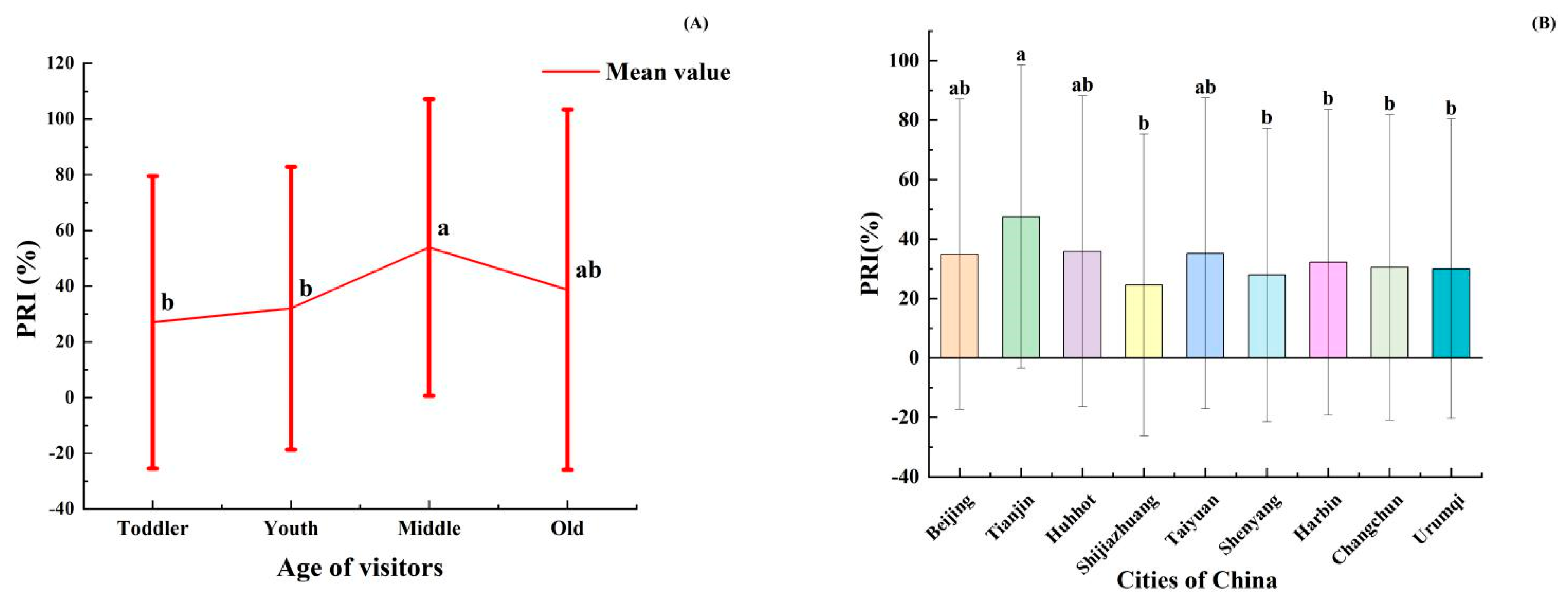
| City | Forest Park | Coordinate | Number of Photos |
|---|---|---|---|
| Huhhot | 1. Hadamen National Forest Park | 41°01′ N, 111°58′ E | 53 |
| 2. Daqingshan Wildlife Park | 40°88′ N, 111°62′ E | 100 | |
| Taiyuan | 3. Taiyuan Forest Park | 37°91′ N, 112°54′ E | 178 |
| 4. Wenying Park | 37°87′ N, 112°57′ E | 75 | |
| Shijiazhuang | 5. Century Park | 38°02′ N, 114°54′ E | 111 |
| 6. Xiushui Park | 38°09′ N, 114°39′ E | 86 | |
| Beijing | 7. Olympic Forest Park | 40°02′ N, 116°39′ E | 76 |
| 8. Grand Canal Forest Park | 39°88′ N, 116°74′ E | 142 | |
| Tianjin | 9. Pak Ning Park | 39°17′ N, 117°22′ E | 90 |
| 10. Tanggu Forest Park | 39°10′ N, 117°67′ E | 125 | |
| Urumqi | 11. People’s park | 43°80′ N, 87°61′ E | 91 |
| 12. Tianshan Canyon | 43°49′ N, 87°44′ E | 134 | |
| Shenyang | 13. Beiling Park | 41°85′ N, 123°43′ E | 133 |
| 14. Changbai Island Forest Park | 41°75′ N, 123°39′ E | 141 | |
| Changchun | 15. Jingyuetan Scentic Spot | 43°78′ N, 125°48′ E | 180 |
| 16. South Lake Park | 43°86′ N, 125°31′ E | 160 | |
| Harbin | 17. Heilongjiang Forest Botanical Garden | 45°71′ N, 126°65′ E | 43 |
| 18. Sun Island Park | 45°79′ N, 126°60′ E | 113 |
| City | Forest Park | Green Area (ha) | Water Area (ha) | Forest Park Area (ha) | Forest Park Elevation (m) |
|---|---|---|---|---|---|
| Huhhot | Hadamen National Forest Park | 2970.00 | none | 3600.00 | 1832.73 |
| Daqingshan Wildlife Park | 521.73 | none | 820.00 | 1137.47 | |
| Taiyuan | Taiyuan Forest Park | 95.90 | 25.73 | 224.00 | 778.59 |
| Wenying Park | 3.37 | 3.96 | 11.90 | 788.83 | |
| Shijiazhuang | Century Park | 11.29 | 3.53 | 28.82 | 62.26 |
| Xiushui Park | 38.29 | 10.90 | 66.70 | 84.20 | |
| Beijing | Olympic Forest Park | 404.22 | 42.86 | 680.00 | 35.81 |
| Grand Canal Forest Park | 546.66 | 166.66 | 713.33 | 7.86 | |
| Tianjin | Pak Ning Park | 7.74 | 9.55 | 57.87 | 4.58 |
| Tanggu Forest Park | 117.73 | 33.39 | 460.00 | 5.20 | |
| Urumqi | People’s park | 15.98 | 1.22 | 30.15 | 870.20 |
| Tianshan Canyon | 89,104.68 | none | 103,848.54 | 2075.52 | |
| Shenyang | Beiling Park | 233.99 | 26.70 | 356.74 | 37.33 |
| Changbai Island Forest Park | 25.95 | 4.19 | 40.25 | 32.81 | |
| Changchun | Jingyuetan Scentic Spot | 6033.38 | 530.00 | 9638.00 | 255.61 |
| South Lake Park | 86.59 | 58.13 | 222.34 | 209.66 | |
| Harbin | Heilongjiang Forest Botanical Garden | 86.34 | 2.16 | 136.00 | 140.63 |
| Sun Island Park | 2126.38 | 103.63 | 3800.76 | 115.26 |
| Variable | Sum of Squares | DF 1 | Mean Square | Sig. 2 | |
|---|---|---|---|---|---|
| Green area | City Inter-group | 545,980,466,666.19 | 8.00 | 68,247,558,333.27 | 0.000 |
| City Intra-group | 433,477,010,268.79 | 2022.00 | 214,380,321.60 | ||
| Total | 979,457,476,934.99 | 2030.00 | |||
| Water area | City Intergroup | 24,308,520.10 | 8.00 | 3,038,565.01 | 0.000 |
| City Intra-group | 20,032,288.71 | 2022.00 | 9907.17 | ||
| Total | 44,340,808.81 | 2030.00 | |||
| Forest-park area | City Inter-group | 734,483,266,261.66 | 8.00 | 91,810,408,282.71 | 0.000 |
| City Intra-group | 592,347,112,110.87 | 2022.00 | 292,951,094.02 | ||
| Total | 1,326,830,378,372.53 | 2030.00 | |||
| Forest-park elevation | City Inter-group | 642,193,245.86 | 8.00 | 80,274,155.73 | 0.000 |
| City Intra-group | 95,747,708.43 | 2022.00 | 47,352.97 | ||
| Total | 737,940,954.30 | 2030.00 | |||
| Source of Variance | Sum of Squares | DF 1 | Mean Square | Sig. 2 | |
|---|---|---|---|---|---|
| Happy | Age Inter-group | 45,251.894 | 3 | 15,083.965 | 0.000 |
| Age Intra-group | 3,360,420.586 | 2027 | 1657.83 | ||
| Total | 3,405,672.48 | 2030 | |||
| Sad | Age Inter-group | 2938.082 | 3 | 979.361 | 0.009 |
| Age Intra-group | 518,526.228 | 2027 | 255.81 | ||
| Total | 521,464.31 | 2030 | |||
| Neutral | Age Inter-group | 43,757.541 | 3 | 14,585.847 | 0.000 |
| Age Intra-group | 2,437,688.961 | 2027 | 1202.609 | ||
| Total | 2,481,446.502 | 2030 | |||
| PRI 3 | Age Inter-group | 51,707.131 | 3 | 17,235.71 | 0.000 |
| Age Intra-group | 5,315,552.956 | 2027 | 2622.374 | ||
| Total | 5,367,260.086 | 2030 | |||
| Source of Variance | Sum of Squares | DF 1 | Mean Square | Sig. 2 | |
|---|---|---|---|---|---|
| Happy | City Inter-group | 55,801.983 | 8 | 6975.248 | 0.000 |
| City Intra-group | 3,349,870.497 | 2022 | 1656.711 | ||
| Total | 3,405,672.48 | 2030 | |||
| Sad | City Inter-group | 2669.126 | 8 | 333.641 | 0.239 |
| City Intra-group | 518,795.184 | 2022 | 256.575 | ||
| Total | 521,464.31 | 2030 | |||
| Neutral | City Inter-group | 40,370.52 | 8 | 5046.315 | 0.000 |
| City Intra-group | 2,441,075.982 | 2022 | 1207.258 | ||
| Total | 2,481,446.502 | 2030 | |||
| PRI 3 | City Inter-group | 74,121.697 | 8 | 9265.212 | 0.000 |
| City Intra-group | 5,293,138.389 | 2022 | 2617.774 | ||
| Total | 5,367,260.086 | 2030 | |||
| Source | Variable | III Sum of Squares | DF 1 | Mean Squares | Sig. 2 |
|---|---|---|---|---|---|
| Model | Happy | 147,640.354 | 31 | 4762.592 | 0.000 |
| Sad | 19,413.101 | 31 | 626.229 | 0.000 | |
| Neutral | 111,873.975 | 31 | 3608.838 | 0.000 | |
| PRI 3 | 219,572.676 | 31 | 7082.99 | 0.000 | |
| City | Happy | 38,955.391 | 8 | 4869.424 | 0.002 |
| Sad | 9424.833 | 8 | 1178.104 | 0.000 | |
| Neutral | 20,564.952 | 8 | 2570.619 | 0.027 | |
| PRI 3 | 75,966.925 | 8 | 9495.866 | 0.000 | |
| Age | Happy | 26,088.062 | 3 | 8696.021 | 0.001 |
| Sad | 2551.57 | 3 | 850.523 | 0.017 | |
| Neutral | 21,006.118 | 3 | 7002.039 | 0.001 | |
| PRI 3 | 36,141.331 | 3 | 12,047.11 | 0.003 | |
| City × Age | Happy | 55,217.161 | 20 | 2760.858 | 0.028 |
| Sad | 13,185.125 | 20 | 659.256 | 0.000 | |
| Neutral | 36,484.372 | 20 | 1824.219 | 0.060 | |
| PRI 3 | 100,695.677 | 20 | 5034.784 | 0.007 |
| Index | Happy | Sad | Neutral | PRI 1 | Green Area | Water Area | Park Area | Park Elevation |
|---|---|---|---|---|---|---|---|---|
| Happy | 1 | |||||||
| Sad | −0.731 ** | 1 | ||||||
| Neutral | −0.886 ** | 0.522 ** | 1 | |||||
| PRI 1 | 0.936 ** | −0.882 ** | −0.768 ** | 1 | ||||
| Green area | 0.052 * | −0.001 | −0.053 * | 0.039 | 1 | |||
| Water area | 0.014 | 0.012 | −0.02 | 0.006 | 0.324 ** | 1 | ||
| Park area | 0.071 ** | −0.011 | −0.070 ** | 0.056 * | 0.984 ** | 0.319 ** | 1 | |
| Park elevation | −0.026 | 0.015 | 0.028 | −0.027 | 0.286 ** | −0.422 ** | 0.261 ** | 1 |
Publisher’s Note: MDPI stays neutral with regard to jurisdictional claims in published maps and institutional affiliations. |
© 2021 by the authors. Licensee MDPI, Basel, Switzerland. This article is an open access article distributed under the terms and conditions of the Creative Commons Attribution (CC BY) license (https://creativecommons.org/licenses/by/4.0/).
Share and Cite
Liu, P.; Liu, M.; Xia, T.; Wang, Y.; Guo, P. The Relationship between Landscape Metrics and Facial Expressions in 18 Urban Forest Parks of Northern China. Forests 2021, 12, 1619. https://doi.org/10.3390/f12121619
Liu P, Liu M, Xia T, Wang Y, Guo P. The Relationship between Landscape Metrics and Facial Expressions in 18 Urban Forest Parks of Northern China. Forests. 2021; 12(12):1619. https://doi.org/10.3390/f12121619
Chicago/Turabian StyleLiu, Ping, Mengnan Liu, Tingting Xia, Yutao Wang, and Peng Guo. 2021. "The Relationship between Landscape Metrics and Facial Expressions in 18 Urban Forest Parks of Northern China" Forests 12, no. 12: 1619. https://doi.org/10.3390/f12121619
APA StyleLiu, P., Liu, M., Xia, T., Wang, Y., & Guo, P. (2021). The Relationship between Landscape Metrics and Facial Expressions in 18 Urban Forest Parks of Northern China. Forests, 12(12), 1619. https://doi.org/10.3390/f12121619








